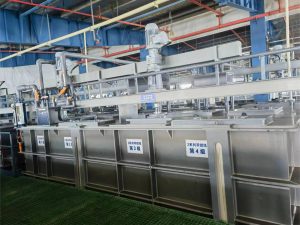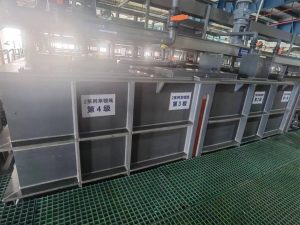Nickel is extracted from ores using froth flotation for sulfides, yielding 15-20% nickel matte, and high-pressure acid leaching for laterites.
Introduction to Nickel and Its Ores
Nickel is a tough, shiny metal commonly used in alloys and plating, and it is most often extracted from two different kinds of nickel ores: sulfides and laterites. Combining, it forms about 60% and 40% of nickel world production output.
Nickel Properties & Importance
Nickel is appreciated for its resistance to corrosion, excellent thermal and electrical conductivity and the ability to alloy with most metals. It is a key ingredient in the production of stainless steel and an important material used in the batteries that power electric vehicles.
Types of Nickel Ores
- Sulfide Ores: These ores are mainly located deep beneath the ground and are harder to come by than laterites. These deposits are deeper, but because they yield several millions of tonnes of ore each year, they are still economic to mine due to their higher nickel content – up to 3% nickel by weight.
- Laterite Ores:These ores are found very near the surface above what is known as a weathering band. While they are more common, being igneous, their lower nickel content (usually <1.5% nickel) and complex mineralogy makes them more difficult, and most traditional processes to extract nickel from them result in the production of ferronickel.
Distribution and Global Reserves
The vast majority of that comes from Indonesia, the Philippines, Russia and Canada, together holding more than 50% of the world’s nickel reserves. Among them, a nickel-rich Indonesia has particularly contributed to global nickel supply chain, particularly with expanding demand for battery applications.
A Boomer in Context and Progress
Although nickel was discovered in the 18th century, its excavating and use as a commercial product and material have grown vastly over the last century. In the late 20th century technology advancements led to new methods for extracting nickel, notably high-pressure acid leaching, a technique for processing laterite ore that has become an industry standard.

Mining Techniques
Mining of nickel ores is a unique operation which has its own features depending on the type of ore being mined for extraction of nickel from nickel ores, the major processes utilized require unique method of mineral processing and extraction and differ from extraction of nickel from sulfide ore. Sulfide ores can be extracted with surface and subsurface mining methods, while laterite ores are generally extracted using surface methods, or a combination of open pit and underground mining methods are used with possible acid leaching to optimize nickel recovery from the ore.
Laterite Ore Surface Mining
Laterite ores are mined through surface mining methods resulting in substantial open-pit created. This is favorable because the ore deposits are not deep to the level. Mechanized and large-scale operations are prevalent in the largest mines in these countries, which remove overburden by mechanical means and extract ore, often by the ton, and often have the capability for processing many thousands of tons each day. In fact, it is much cheaper and more straight forward that the underground mining and hence for the huge nickel laterite deposits the high pressure acid plants are an very attractive feature.
Underground Mining for Sulfide Ores
Underground mining is then employed for an ore body composition of higher nuggets inclosed by hardrugous sulfides. Depending on the shape and orientation of the ore body, several techniques can be employed, including room-and-pillar and cut-and-fill mining. In Canada and Russia – home to much of the world’s richest sulfide nickel deposits – the processes make it possible to selectively extract high-grade nickel ore and significantly reduce shipment costs, which makes up for higher operational costs than surface mining would incur.
Revolutionary mining technology
Nickel mining is being transformed by technological advancement The automated drilling and ore handling machines offer improved productivity and safety in both a surface and underground environment. Notably, real-time data analytics have improved the extraction of ore and waste management processes, substantially decreasing environmental footprints.
Ore Processing Methods
Whether the ore is a sulfide or a laterite plays a critical part in the way it should be processed. Every process is engineered to recover nickel from the ore which is extracted through physical and physiochemical methods designed around the specific ore characteristics.
Processing Sulfide Ores
Initial ore processingApart from sulfidic ores, carcass, frankenstein mineralization and lateritic ores are being excavated in two upgrading methods. The powdered ore is then mixed with water and worked into a slurry containing the nickel compounds and the collectors in froth flotation tanks, and collectors bind chemically to the copper compounds, making them hydrophobic, water-repelling and easy to pull out of the flotation tanks.
Flotation concentrate undergoes smelting which is done in a furnace with flux material at a high temperature. Results in a 15 to 20% Nickel Matte. In the second step, called refining, air is blown over the matte to oxidize further the impurities with the result that the slag floats on top of the melt so that it is easily removed. Finally, purified nickel is now suitable for use in electrolytic refining or treatment with carbon monoxide in the Mond process, creating nickel carbonyl gas which decomposes itself when treated at a high temperature furnace, resulting in highly pure nickel.
Processing Laterite Ores
High-pressure acid leaching (HPAL) is a common HPAL method for laterite ores which have a low nickel content and are resistant to physical concentration methods. The ore is pretreated with a solution of sulfuric acid and dissolved nickel and cobalt into solution by high pressure acid leaching. The solution is then precipitated as mixed hydroxides (mostly for diluted), and then refined to Nickel.
Another method is atmospheric leaching which is best suited for ores which are amenable to lower pressures. The process for extracting nickel is similar, and this method operates under ambient conditions.
Innovations in ore processing
Recent developments in ore processing involved the development of more efficient leaching techniques and more effective processes for purification and recovery. All of which increases the efficiency and environmentally soundness of nickel ore extraction operations collectively.

Refining Techniques
Post-extraction of the nickel, derived from its ore, there are multiple processes through which the nickel can be purified to generate a worthy commercial product. Nickel refining not only increases its purity, but also guarantees that the final product satisfies the strict quality requirements necessary to make the material suitable for multiple uses.
Electrorefining and Electrowinning
This is an important method to transform the nickel adducts produced from sulphide ores to pure nickel by the technique of electrorefining. During this procedure, nickel of low purity is pushed into solution as the anode in an electrolytic cell and pure nickel is deposited onto a cathode. This method usually attains 99.99% purity. In a process known as electrowinning, however, nickel is leached out of laterite ores. The technology is one of direct electrowinning of nickel from the leach solution onto the cathodes, without going through the smelting step.
The Mond Process
The Mond Process is a sophisticated chemical technique used to produce high-purity nickel. The impure nickel reacts with carbon monoxide at 50-60°C to form nickel carbonyl gas. The gas is then decomposed at 200°C, resulting in pure nickel and carbon monoxide, which is recycled back into the process. This method is particularly valued for producing extremely high-purity nickel used in specific industrial applications, such as catalysts and aerospace components.
Hydrometallurgical Processes
Hydrometallurgical refining of nickel is performed using soluble nickel compounds which are precipitated from leach solutions after first reaction to obtain suitable nickel sulfate or other chemicals which can be processed to production of pure nickel metal. This process is widely used for the laterite ore processing, where very smelting process is not applicable Its flexible nature is crafted for recovery of other valuable metals as well (cobalt) to get the maximum money from the ore.
What about Nickel Refining Innovations
The refining processes have meanwhile been further developed and made more efficient and environmentally friendly. Solvent extraction techniques have enabled more precise separation of nickel from complex solutions, improving both yield and purity, for example.
